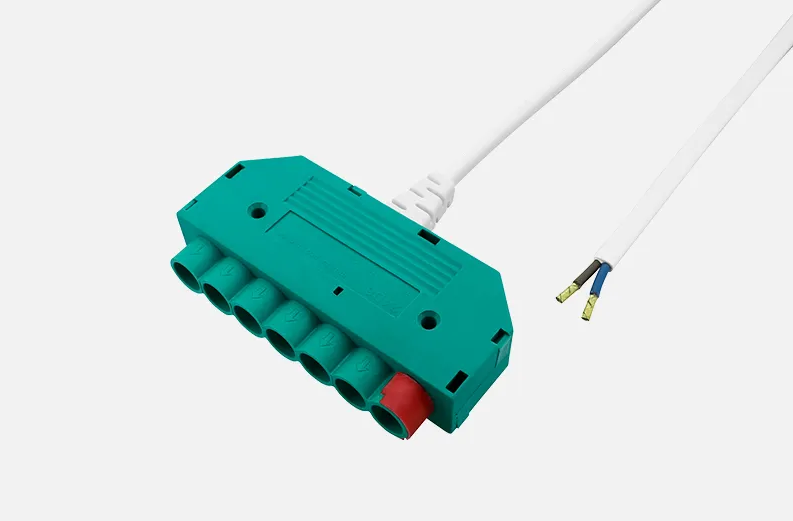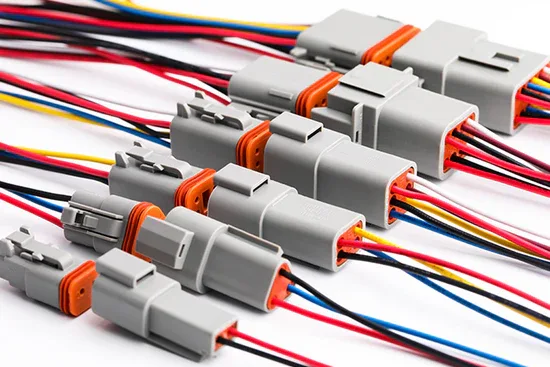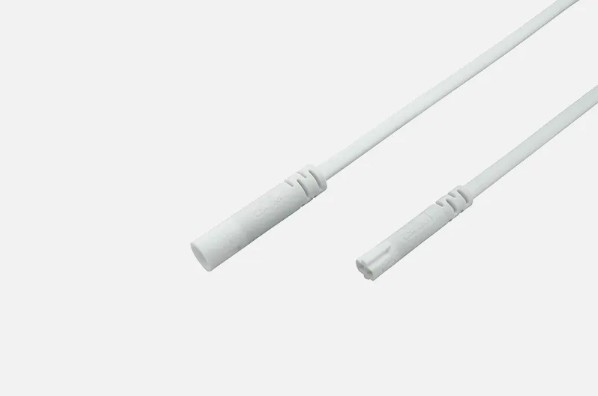Introduction
In the world of lighting technology, LED light splitter have emerged as indispensable tools for achieving versatile and dynamic lighting setups. Whether you’re an avid home decorator, a professional event planner, or a business owner seeking to enhance your ambience, understanding LED light splitters is crucial for optimizing your lighting solutions.

What is an LED Light Splitter?
LED light splitters, also known as LED splitters or LED strip splitters, are devices designed to divide the output of a single LED light source into multiple paths. This allows users to control and distribute light across different areas or fixtures using a single source, providing flexibility and efficiency in lighting arrangements.
Types of LED Light Splitters
There are primarily two types of LED light splitters:
- Passive Splitters: These splitters use simple circuitry to divide the light output without any additional power source. They are often used for basic lighting setups where precise control is not required.
- Active Splitters: Active splitters incorporate electronics to not only split the light but also provide advanced control features such as dimming, colour changing, and synchronization. They are ideal for applications requiring dynamic lighting effects and precise adjustments.
LED Light Splitter Manufacturer and Supplier
When considering LED light splitters for your lighting needs, it’s essential to choose a reputable manufacturer and supplier. Quality craftsmanship and reliable performance are critical factors in ensuring the longevity and effectiveness of your lighting setup.
How Does an LED Light Splitter Work?
LED light splitters operate on a relatively simple principle, yet their functionality can vary depending on the type and features of the splitter.
Working Principle
Whether it’s a passive or active splitter, the basic working principle involves dividing the incoming electrical signal or light output into multiple channels. This is achieved by arranging circuitry or electronic components within the splitter.
In a passive splitter, the incoming signal is typically divided using passive components such as resistors, capacitors, or simple electrical connections. These components ensure that the voltage or current is evenly distributed among the output channels.
On the other hand, active splitters incorporate more complex electronics such as integrated circuits (ICs) or microcontrollers. These components split the signal and offer additional functionalities like signal amplification, signal processing, and control interfaces.
Components and Their Roles
The components within an LED light splitter play crucial roles in its operation:
- Input Connector: This is where the LED light source is connected to the splitter.
- Output Connectors: These connectors distribute the divided signal to individual LED fixtures or groups of fixtures.
- Circuitry/Electronics: In active splitters, this includes ICs, microcontrollers, and other electronic components responsible for signal processing and control.
- Power Supply (Active Splitters): Active splitters may require an external power source, especially if they incorporate features like dimming or colour changing.
Understanding how these components work together is essential for choosing the right LED light splitter for your needs.
Benefits of Using LED Light Splitters
LED light splitters offer a range of advantages that make them a preferred choice for various lighting applications. Here are some key benefits to consider:
Increased Flexibility in Lighting Setups
One of the primary advantages of LED light splitters is their flexibility in configuring lighting setups. By dividing the light output from a single source, users can create intricate lighting designs, customize illumination levels for different areas, and experiment with various lighting effects.
Whether illuminating an ample space with multiple fixtures or accentuating specific features with precise lighting, LED light splitters offer the versatility needed to achieve your desired ambience.
Cost-Effectiveness Compared to Alternative Solutions
LED light splitters can be cost-effective for distributing light across multiple fixtures or areas. Instead of investing in separate light sources for each location, users can utilize a single LED source with a splitter, reducing the overall cost of equipment and installation.
Additionally, LED technology is known for its energy efficiency, helping users save on electricity bills in the long run. With LED light splitters, you can achieve optimal lighting coverage without compromising energy consumption.
Enhanced Control Over Lighting Environments
Another significant advantage of LED light splitters is the level of control they offer over lighting environments. Active splitters, in particular, come equipped with advanced control features such as dimming, colour changing, and synchronization.
These features allow users to adjust the lighting’s intensity, colour, and timing according to their preferences or specific requirements. Whether creating dynamic lighting effects for events, setting the mood in hospitality venues, or optimizing workspace illumination, LED light splitters empower users to tailor the lighting experience to suit their needs.
With these benefits in mind, it’s clear why LED light splitters are popular for a wide range of lighting applications. In the next section, we’ll discuss important considerations to keep in mind when choosing an LED light splitter for your project.
Considerations When Choosing an LED Light Splitter
Selecting the right LED light splitter involves several important considerations to ensure compatibility, reliability, and performance. Here are some key factors to keep in mind:
Compatibility with Existing Lighting Systems
Before purchasing an LED light splitter, assessing its compatibility with your existing lighting setup is crucial. Consider factors such as the type of LED fixtures you use, the voltage and current requirements, and the available control interfaces.
Ensure the splitter is compatible with your lighting system’s specific protocols or standards, such as DMX or DALI, for professional installations. Compatibility issues can lead to functionality issues or even damage to the equipment, so thorough compatibility testing is essential.
Durability and Quality of Materials
The durability and quality of materials used to construct the LED light splitter are essential considerations, especially for long-term reliability. Look for splitters made from high-quality materials that can withstand environmental factors such as temperature fluctuations, moisture, and physical impacts.
Check for certifications or compliance with industry standards to ensure that the splitter meets quality and safety requirements. Investing in a durable and well-built LED light splitter can help prevent premature failure and costly replacements.
Capacity and Scalability for Future Expansions
Consider the capacity and scalability of the LED light splitter to accommodate future expansions or changes to your lighting setup. Determine the maximum number of output channels supported by the splitter and whether it can handle the anticipated load of LED fixtures.
Additionally, assess whether the splitter offers features or configurations that allow for easy expansion or reconfiguration of the lighting system. This flexibility is essential for projects that may grow or evolve, allowing you to adapt your lighting setup to changing needs or preferences.
By carefully considering these factors, you can choose an LED light splitter that meets your requirements and ensures optimal performance for your lighting project.
Common Applications of LED Light Splitters
LED light splitters find applications across various industries and settings thanks to their versatility, efficiency, and control capabilities. Here are some common scenarios where LED light splitters are used:
Home Lighting Setups
In residential settings, LED light splitters are often used to create customized lighting arrangements for various rooms and spaces. Whether accentuating architectural features, illuminating artwork, or providing ambient lighting in living areas, LED splitters allow homeowners to design lighting schemes tailored to their preferences.
For example, an LED light splitter can divide the output of a single LED strip into multiple sections, allowing for independent control of lighting levels and colors in different parts of a room. This versatility makes LED splitters a popular choice for interior designers and home automation enthusiasts looking to enhance the ambience and functionality of their living spaces.
Stage and Event Lighting
In the entertainment industry, LED light splitters are crucial in stage lighting and event production. From concerts and theatrical performances to corporate events and weddings, LED splitters enable lighting designers to create dynamic and immersive experiences for audiences.
By dividing the output of powerful LED fixtures into multiple channels, lighting designers can achieve intricate lighting effects, synchronize lighting cues with audiovisual elements, and adapt the lighting setup to different stages or scenes. LED splitters with advanced control features such as DMX compatibility and wireless connectivity offer even greater flexibility and creativity in lighting design.
Industrial and Commercial Lighting Solutions
In industrial and commercial settings, LED light splitters optimize lighting efficiency and productivity while minimizing energy consumption and maintenance costs. LED splitters, from warehouses and factories to retail stores and office buildings, help businesses create well-lit environments that enhance safety, productivity, and employee comfort.
For example, in warehouse facilities, LED splitters can divide the output of high-bay LED fixtures to effectively illuminate aisles, storage racks, and work areas. By zoning the lighting and incorporating motion sensors or programmable controls, businesses can reduce energy waste and create a more responsive and adaptive lighting system.
Installation and Maintenance Tips
Proper installation and maintenance are essential for maximizing the performance and longevity of LED light splitters. Here are some tips to help you get the most out of your LED light splitter:
Step-by-Step Installation Guide
- Plan Your Layout: Before installing the LED light splitter, carefully plan the layout of your lighting setup, including the placement of LED fixtures and the routing of cables.
- Select a Suitable Location: Choose a suitable location for the LED light splitter, ensuring easy access for wiring and maintenance.
- Connect Power: If using an active splitter, ensure it is correctly connected to a power source according to the manufacturer’s instructions.
- Connect LED Fixtures: Connect the LED fixtures to the splitter output connectors, observing polarity and making the splitter’s output connectors, observing polarity and making secure connections.
- Test the Setup: After installation, test the lighting setup to ensure that all fixtures functionfunction correctly and that the splitter distributesdistributes the light as intended.
Best Practices for Maintenance
- Regular Inspection: Periodically inspect the LED light splitter and associated components for signs of wear, damage, or loose connections. Address any issues promptly to prevent performance degradation or failure.
- Cleanliness: Keep the area around the LED light splitter clean and free of dust, debris, and moisture, affecting performance and reliability.
- Temperature Management: Ensure proper ventilation and temperature control near the LED light splitter to prevent overheating, which can reduce lifespan and reliability.
- Firmware Updates (If Applicable): If your LED light splitter includes firmware or software for control and programming, periodically check for updates provided by the manufacturer to ensure compatibility and access to new features or improvements.
- Professional Maintenance: For complex or large-scale lighting installations, consider engaging professional technicians or electricians for periodic maintenance and troubleshooting to ensure optimal performance and safety.
Following these installation and maintenance tips ensures that your LED light splitter operates reliably and efficiently, providing years of high-quality lighting for your various applications.
FAQs About LED Light Splitters
Here are answers to some frequently asked questions about LED light splitters:
Q: What are the main differences between passive and active splitters?
A: Passive splitters rely on simple circuitry to divide the light output without any additional power source. They are straightforward and cost-effective but offer limited control features. On the other hand, active splitters incorporate electronics to not only split the light but also provide advanced control features such as dimming, colour changing, and synchronization. They offer greater flexibility and customization but may require an external power source.
Q: Can LED light splitters be used with different LED lights?
A: Yes, LED light splitters are compatible with various LED lights, including LED strips, modules, bulbs, and fixtures. However, to avoid compatibility issues or damage to the equipment, it’s essential to ensure that the voltage, current, and control interfaces are compatible between the splitter and the LED lights.
Q: How do I troubleshoot common issues with LED light splitters?
A: Common issues with LED light splitters include connectivity problems, flickering lights, or uneven illumination. To troubleshoot these issues, first, check for loose connections or damaged cables and connectors. Ensure the power supply is adequate and stable, and verify compatibility with the LED fixtures. If the issue persists, consult the manufacturer’s documentation or seek assistance from technical support.
By addressing these frequently asked questions, we hope to clarify the features and capabilities of LED light splitters, helping you make informed decisions about your lighting projects.
Conclusion
In conclusion, LED light splitters are versatile and efficient tools for creating dynamic and customizable lighting setups across various applications. LED splitters offer flexibility, control, and efficiency, whether illuminating your home, enhancing stage performances, or optimizing industrial environments.
By understanding how LED light splitters work, considering essential factors during selection and installation, and following best practices for maintenance, you can maximize the performance and longevity of your lighting setup.
If you have any further questions or need assistance with LED light splitters, don’t hesitate to contact reputable manufacturers or suppliers for expert guidance and support. Thank you for reading, and we hope this guide has been helpful in your journey with LED lighting technology.



